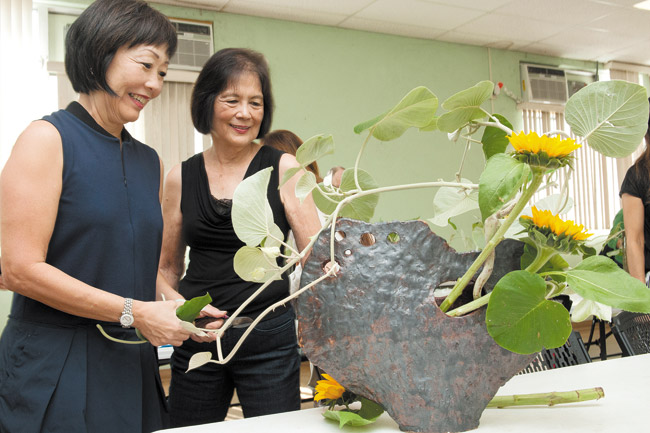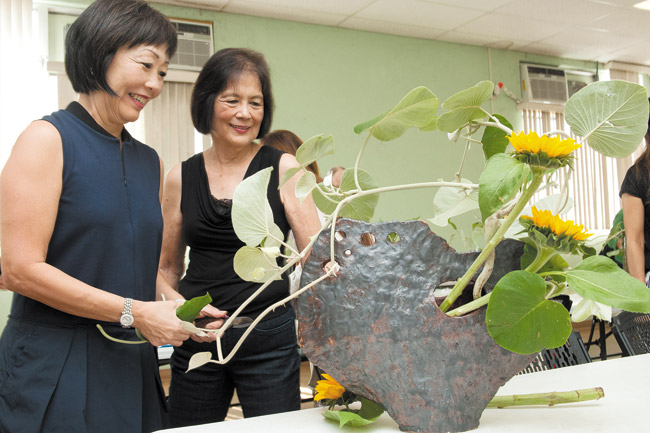Let The Flowers Speak
Before creating a floral work of art, ikebana practitioners first listen to the various materials. ‘you never know what is going to happen,’ says one
If we could see the miracle of a single flower clearly, our whole life would change
mw-riv-040115-ikebana-1
It’s a philosophy rooted in Buddhism that aptly describes ikebana. Because it isn’t just a way to display a love for flowers — ikebana ultimately leads to a heightened awareness of nature itself.
“It really makes you appreciate the beauty that we have,” says Linda Hamasaki, who for about 14 years has taught this ancient Japanese style of floral arrangement.
“I love flowers,” proclaims Carole Sakata, also an ikebana teacher of more than 20 years. “But as much as I love flowers, I like to create things.”
Ikebana 101
In its simplest form, ikebana is three-dimensional art.
Really, ikebana can be representative of many things. Whatever the final design depends on what the materials speak to each artist.
“You never know what’s going to happen,” says David Leonetti, who has been taking ikebana lessons for more than 20 years. “Part of learning it is letting the flowers in the container lead the way.”
As much as ikebana curriculum sometimes encourages artists to express themselves freely, it also is about control.
It’s a method that illustrates yin and yang, which makes sense since some believe ikebana originated in China before it took shape in Japanese culture some 500 years ago.
Unlike Western arrangements, in which color is a key element, Sakata and Hamasaki point to other principles ikebana arrangements should incorporate, like space, shape, balance and movement.
“You really have to communicate with the material and understand your material to see what it will allow you to do,” says Hamasaki. “When you finish your arrangement, it should imbue some kind of feeling between the viewer and the arrangement.”
It requires a level of skill and discipline that, after 19 years, Joyce Tomonari still is learning.
“You never feel you’re good,” she says. “You always feel like, ‘What can I do? How can I do better?'”
It’s a lament Hamasaki and Sakata understand well. Together, they are two of Honolulu’s most prominent ikebana teachers — Hamasaki having learned from the late Alice Uchigakiuchi, and Sakata training in Japan. But learning, they say, never ends.
“I’ve learned so much from my students,” says Sakata.
“It’s a path that you take, it’s a journey,” adds Hamasaki, of what she tells students. “There are new discoveries, new ways of doing things.”
There really is no way of knowing how quickly someone will learn the art. Sakata notes that many who begin with some knowledge of plants and flowers or who grew up around ikebana tend to pick it up faster.
But in ikebana there is no such thing as a right or wrong way to create an arrangement.
“Individuals will look at it and, of course, judge it, but there’s no contest,” says Hamasaki. “It’s your self-expression to share with others.”
Sogetsu Ikebana
Much like the basic principles that guide ikebana, each arrangement also addresses a theme — a specific type of material, or curved lines instead of straight, for example.
On most days, Hamasaki, Sakata and their students arrange table-sized ikebana. Other times, though, they may be creating larger installation pieces.
It’s one characteristic specific to the Sogetsu School of ikebana, to which both belong. Throughout the world, there are more than 3,000 different schools. Among the most prominent are Ikenobo, Ohara and Sogetsu.
Locally, Sogetsu Hawaii Branch is one of the largest in the United States. Led by Sakata as its director and Hamasaki as deputy director, the group consists of more than 150 members.
Sogestu ikebana stresses creativity and allows students to experiment with freestyle design after basic lessons are completed. Materials also sometimes include unconventional ones like plastic or paper.
In allowing this type of freedom, Sogetsu ikebana, and ikebana in general, become a different way of life.
A tree, for instance, is not just a tree — it’s potential for art, with branches that will create delicately curved lines and leaves for added texture.
“The materials, if you’re gentle, can be pliable at times and develop a character that you didn’t think the materials had in the beginning,” says Elizabeth Lacy, who has been taking classes off and on for 10 years.
But as much as ikebana is a reflection of the artist, it also is very much about the joy it inspires after it is created.
“(I have learned) how much enjoyment the arrangements give each of us when we take them home and others can enjoy them with us,” says Lacy.
Sometimes, student work may be found in exhibits at Honolulu Museum of Art. Sakata and Hamasaki also display their work as interior pieces in Macy’s and Neiman Marcus stores, respectively.
Ultimately, ikebana is a selfless art.
“You want to share your ikebana with people,” adds Hamasaki. “You don’t do it for yourself.”







